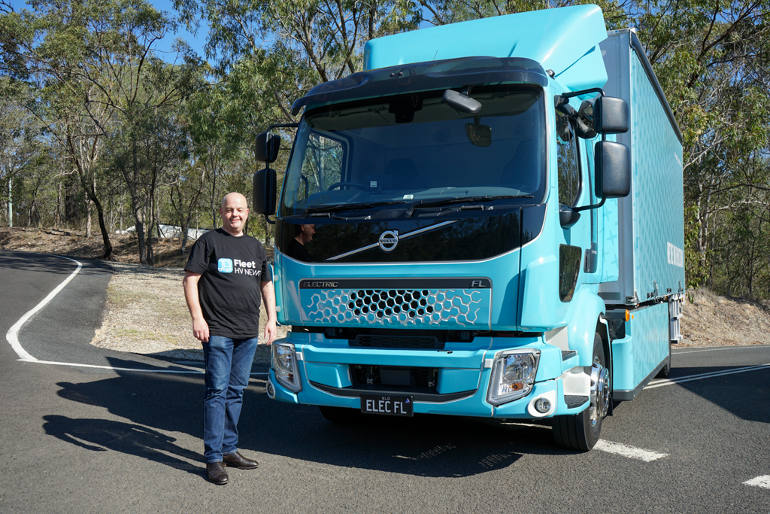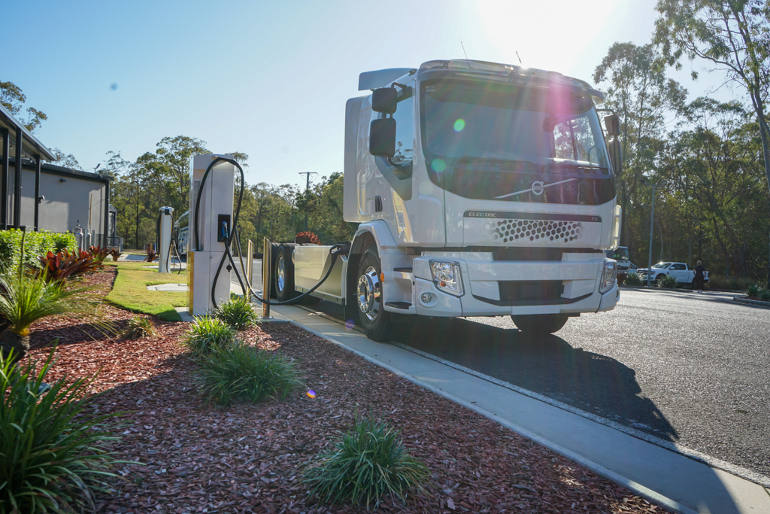Volvo are leading the way in zero emission transport, launching a range of electric trucks that are ready to hit the road and get to work, including here in Australia. From their small rigid trucks, the FL and FE, up to their heavy duty range, the FMX, FM and even the largest cab, the FH, Volvo have a BEV solution.
And Fleet HV News were invited to drive them around the proving grounds in Brisbane to see how Electric trucks will compare against their diesel counterparts.
After stringent testing around the world in various applications, Volvo have developed a range of electric trucks that offer real zero emissions solutions, particularly for urban and regional distribution, with GCMs up to 44 tonnes.
Volvo are targeting a reduction in emissions from their Trucks and Buses by 40% per vehicle km by 2030, and a complete end to using fossil fuels by 2040. So, with only 16 years to go, development in zero emission vehicles is moving at an impressive rate. Volvo aren’t just making electric trucks to compete with Diesel but aim to make them the preferred choice for operators.
Volvo’s move to electrification involves modifying their existing tried and tested systems to work with electric motors, such as their impressive i-shift transmission. This will make the transition much easier for drivers and workshops over the next decade, whilst also keeping their trucks as reliable as possible.
The smaller FL Electric uses one motor, the FE Electric uses two, whilst the FM, FMX and FH Electric use three motors which offer up to 490 kW (666 hp) of continuous power. However, it’s the gearbox torque figure of up to 28,000 Nm that stands out, in comparison to say a Volvo FH700 with 3,150 Nm.
Combined with 450-540 kWh capacity across 5-6 batteries, Volvo are claiming a range of up to 300 km which will be ideal for operators on urban and regional distribution who are looking to reduce their operating costs and emissions.
Batteries and service boxes are fitted alongside the chassis where you would normally see the fuel tanks. Built by Volvo, the battery boxes use an array of Li-Ion Samsung cells, offering 90 kWh of power each and weighing around 500 kg, so you need to be careful when choosing how much range you really need.
For those who require power take-off (PTO) there are three options for a range of applications, one electric (40kW), one electro-mechanical (70kW) and one gearbox-mounted (150kW).
Fortunately, recent announcements by SA and NSW Governments will mitigate the issue of increased weights, allowing trials of zero emission trucks up to 8 tonne on a single steer axle and up to 18.5 tonnes on the drive axle, where the overall gross vehicle mass (GVM) of the prime mover does not exceed 26 tonnes. Also, the Federal Government’s announcement to increase the overall width to 2.55 metres will also help the transition to BEV.
To get back to full charge, with a 250 kW DC charger full charge can be achieved within 2.5 hours, or 9.5 hours on a 43 kW AC charger. However, if you can adjust your operations and maybe charge during the day whilst your drivers are on a break or reloading, you may find electric charging becomes much easier and less of an issue than finding a service station.
Climbing into the cab of the FM and FH Electric is just like their Diesel siblings. Everything is familiar and if you have a fleet of trucks, it will be easy for a driver to jump from one to another. Recent interior updates to the Volvos have really improved the looks and usability too, with a larger all-digital dash across two screens.
The main dash can easily be configured to your liking, and the second auxiliary touchscreen is for entertainment, navigation and turns into a blindspot camera when you indicate which is a great feature. And with all the controls mounted on the steering wheel, it is a very simple system to use once you are familiar with it.
The differences really become apparent when you turn the keys, with no noise, you really have to use the dash to know when you are ready to go.
Pulling away, the Electric power gives you linear, smooth and powerful acceleration that we’ve come to expect with BEVs. The motors deliver loads of low-down torque which makes for a very positive drive.
The trucks always start in the highest possible gear for energy efficiency with minimum gear changes. Ours started in 7th and went straight to 12th. The linear surge in power is amazing from standstill, feeling like we were bobtail even with a GCM of 35 tonnes.
To slow you down, there are three-stages in regenerative braking, which means you can adjust the amount of retardation you’re getting from the motors like an engine brake, just more effective and without the coasting in between. This is where you will really need to train your drivers to get the most out of the electric truck and drive efficiently.
On the twists, the electric trucks use Volvo’s electric steering system called Volvo Dynamic Steering (VDS). The system has been available for a while, and combined with the electric driveline it really makes the drive relaxing and smooth.
Overall, the Electric truck range impressed in every area. Considering the technology is only just emerging it is exciting to see where they will be in 10 years.
Initially, the purchase price, limited range and increase in tare weight is a hurdle that Truck manufacturers will need to overcome before mass adoption, but we are confident Volvo and the other main manufacturers will get us there.
We’ve seen the range double in Electric cars over the past 3 years whilst prices have reduced, so if the same trend happens in Trucking, then maybe you will see BEV trucks with a 1,000 km range pulling bdoubles along the East Coast within this decade. After driving the FH and FM Electrics, I hope so.

Likes
- Smooth, Quiet and Powerful driveline
- No more filling up with Diesel
Dislikes
- Initial Price
- Limited range







